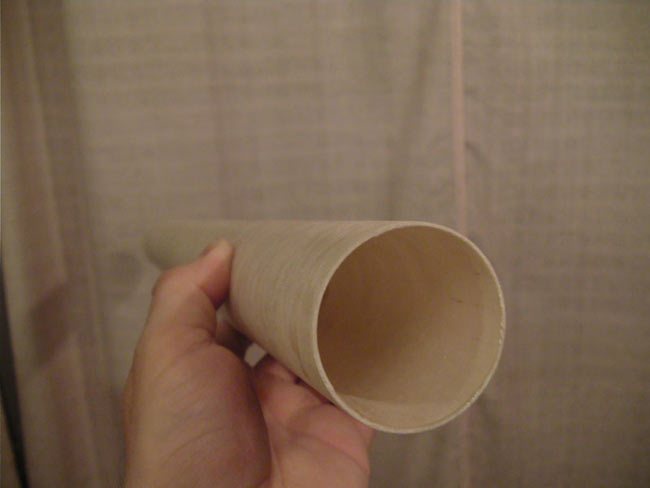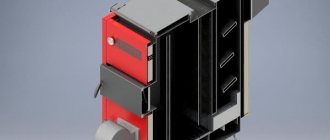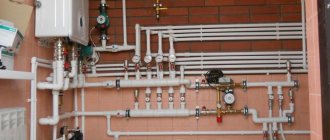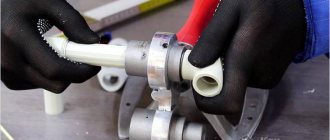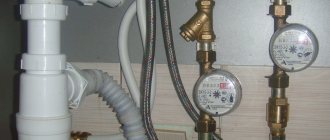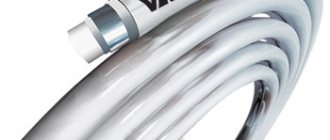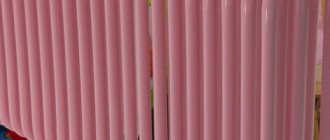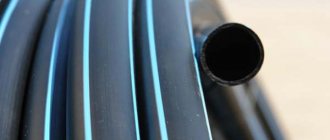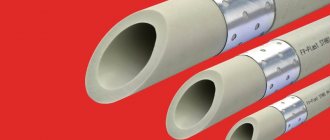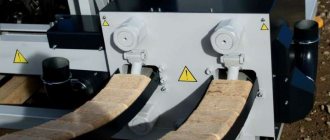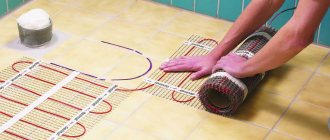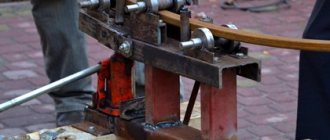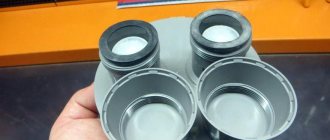general characteristics
Fiberglass-reinforced pipes create serious competition for analogs reinforced with aluminum foil. These risers are characterized by a three-layer construction: polypropylene - fiberglass - polypropylene. The reinforcing layer is also made of propylene, reinforced with fiber fibers - glass fibers. In terms of its technical parameters, the adhesion of plastic to fiberglass can be compared to the strength of a monolith.
For fiberglass-reinforced pipes, the following marking is characteristic: PPR-FB-PPR.
If we compare the risers with an aluminum and fiberglass frame, then the first option has one significant advantage: the products have greater rigidity. This means that when installing systems with a length of 1.5 meters or more, such risers must be fixed to the walls with special fasteners. Otherwise, sagging, deformation, failure of the structure is possible.
Regarding diameters, it should be noted that products can be produced with a diameter of 20 mm to 110 mm. It is these risers that can be found on sale more often than others. Although, for example, elements with a diameter of 17 mm or less are used for arranging underfloor heating.
Products of small diameters are fixed with plastic clips, and large ones - with clamps.
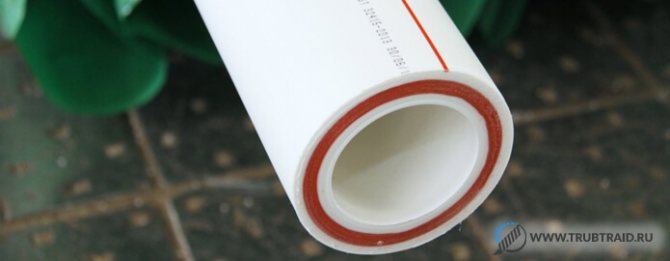
Let's compare the advantages and disadvantages of fiberglass and aluminum reinforcement
Comparative characteristics of polypropylene pipes with an aluminum layer and reinforced with fiberglass are carried out according to their key indicators:
- Linear expansion when heated. The value of this indicator is the same and ranges from 0.03 to 0.035 millimeters per meter.
- The reliability of the reinforcing layer. Due to the special manufacturing technology, the fiberglass layer is more uniform, the products are made without seams and joints. The aluminum braid is fastened by welding, a seam is formed at the joints, and in some modifications the foil coating is overlapped. It can be concluded that the aluminum layer loses in this regard to fiberglass reinforcement.
- Resistance of the material to oxygen diffusion. The fiberglass layer reliably protects the cavity from the penetration of oxygen molecules. The foil coating is oxygen permeable, which leads to the development of oxygen corrosion.
- Ease of installation and strength of connections. Soldering polypropylene pipes with an aluminum layer requires attention and accuracy. In order not to damage the reinforcing layer, a preliminary cleaning is performed. The glass fiber reinforced polypropylene pipe is assembled without pre-treatment.
- Thermal conductivity. Compared to fiberglass-reinforced piping, piping made of polypropylene pipes with an aluminum layer heats up faster.
- Environmental Safety. Polypropylene does not emit toxic substances and therefore installation from this raw material is allowed in residential premises and public buildings.
- Plastic. Both types of products work equally well under conditions of overheating by a high temperature of the coolant. Even in contact with hot water heated to the boiling point, the piping retains its original shape and system integrity.
If we compare the technology for the production of reinforced polypropylene pipes, the conclusion suggests itself that fiberglass reinforcement is a more advanced development with great prospects for development.
Polypropylene products
The technical characteristics of glass fiber reinforced polypropylene pipes depend on the polymer used for their manufacture. All products are marked, which makes it possible to immediately determine the areas of use of tubular parts.
Let's find out what the markings on the pipes mean. So, PPR - English, and PPR - Russian name means that it is a Polypropylene pipe made of Random copolymer.
Such polypropylene pipes reinforced with fiberglass are used for heating, water supply, ventilation systems, industrial pipelines.
When arranging engineering networks, PPR pipes reinforced with fiberglass are increasingly used. There is nothing strange in this, since they are reliable, light enough, and there are much fewer problems with their installation.
Another important factor is cost. For example, the price of PPR pipes reinforced with fiberglass for heating is lower than metal counterparts, which helps to save the family budget. These, as well as other characteristics possessed by a polypropylene pipe reinforced with fiberglass, contributed to its popularization and application in various spheres of the national economy.
Read from this article: The main characteristics and scope of polypropylene pipes, diameter and what affects its choice. Classification by pressure and composition of raw materials. Polar questions and answers to them.
The approximate cost of fiberglass pipes
The modern assortment of the products described in the article is quite large, and therefore there are many manufacturers. Nevertheless, they all manufacture pipes in accordance with GOST, and therefore the dimensions and characteristics must be identical. But still, let's get acquainted with the features of several types of pipes, as well as find out today's average market prices. For the convenience of our website visitors, all the information below is given in the form of a small table.
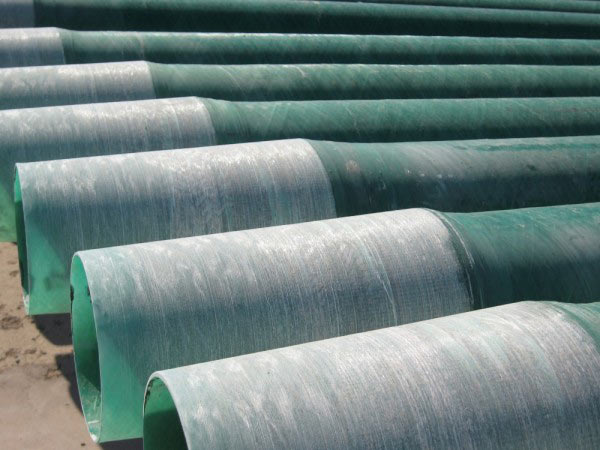

Table. How much is fiberglass pipes - prices, characteristics.
| Name, photo | Short description | Average market value, in rubles |
| 1. Profile pipe made of fiberglass | The dimensions of the product are as follows - 10x5x0.6 centimeters (HxWxT). As for the weight, in this case it is 3.14 kilograms per linear meter. | From 1250 per meter |
| 2. Profile pipe made of fiberglass | A similar product, only the dimensions differ (in this case, they are 18x6x0.6 centimeters) and, therefore, weight. The density in this case varies between 1,750 and 2,100 kilograms per cubic meter. Note also that the specific strength of this material is the same as that of high-quality steel. | From 2200 |
| 3. Corrugated fiberglass pipe | The dimensions of this product are 3.4x0.9 centimeters, and the weight is 500 grams per meter of length. The inner diameter of such a pipe is 2.5 centimeters. | From 200 |
| 4. Round fiberglass pipe | Its outer diameter is 7 centimeters, while the inner diameter is 5.5 centimeters. The walls of the product are 1.5 centimeters thick. The mass is 2.8 kilograms per meter of length. | From 1150 |
| 5. Round fiberglass pipe | According to its characteristics, this product is very similar to the previous one - its outer diameter is also 7 centimeters, but the inner diameter is already 6 centimeters. The walls are one centimeter thick. | From 800 |
Note! As you can see, the cost can be different and depends on the specific shape of the products, their dimensions and wall thickness. Also, the price may vary depending on the specific manufacturer, but not much. Be that as it may, there are plenty to choose from in any case.


Video - Advantages of fiberglass pipes
What are the types of polymer pipes
At this time, 2 types of polymer products are known:
- single-layer;
- multilayer.
What are the characteristics of each type of product?
Single layer
There are 4 modifications of one-piece polypropylene risers used for heating or water supply.
1st type: PPN pipes.
Homopolypropylene is used for their production. They are used in engineering pipeline structures for cold water supply, ventilation, industrial highways.
2nd type: RRV pipes.
The production is based on polypropylene block copolymer. Products are intended for installation of underfloor heating, cold water supply networks.
3rd type: PPR pipes.
The material for the production of parts is a random polypropylene copolymer. The main property of the substance is to promote an even distribution of loads on the inner walls of pipelines.
Hot, cold water supply, floor heating systems, water radiator heating - this is the list of applications of this type of risers.
4th type: PPs pipes.
The main characteristic of the products: polypropylene with increased heat resistance is used for production.
Details of such a line are able to withstand the temperature of the transported media up to + 95⁰С. If necessary, within a short period of time, it is possible to transport a medium with a temperature of up to + 110⁰С.
The first three analogs are designed to operate at temperatures around + 70⁰С. In a short-term mode, operation is allowed at slightly higher temperature indicators.
Products of the 3rd type are covered with a special shell, which is able to completely eliminate the negative effects of ultraviolet radiation.
Important! Do not often use the system operation in the mode of maximum permissible parameters.
About multilayer analogs
Polypropylene (PP) pipes consisting of several layers are reinforced with fiberglass, used for heating, water supply. In comparison with solid structures, PP products practically do not change their linear dimensions at high temperatures of the transported media. Thanks to this property, the scope of application of solid communications is significantly expanded.
The following modifications of multilayer risers can be distinguished.
Products for the reinforcement of which perforated aluminum foil is used.
They are characterized by the presence, on the outer or middle layer, of small-diameter holes in the form of a mesh. The strength of the bond with the polymer is carried out due to the viscosity, as well as the fluidity of the substance, which penetrates into the holes of the aluminum layer.
Product advantages
- Low coefficient of linear expansion;
- increased strength.
Minuses
- In the process of welding, only the upper layer of the riser is joined to the fittings with sufficient reliability;
- the aluminum reinforcement must be removed before welding, since failure to do this may result in a poor-quality connection.
PP pipes with solid aluminum foil reinforcement.
The foil can be located both on the outer and on the middle layer of the pipe part, but it is imperative that polymer layers are placed on both sides of the metal.
Before starting welding, you need to cross-cut the risers. Thanks to the procedure, the possibility of aluminum contact with the moving medium is excluded.
Benefits
- Low coefficient of thermal expansion;
- increased strength properties.
The disadvantages include:
- not all interlayers are welded reliably. In places of welding, it is absolutely reliable to attach only the outer layer;
- obligatory removal of unnecessary aluminum residues, which takes a lot of time.
Important! To remove the aluminum layer before welding, you need to use a special tool. Its purpose: to accurately measure the depth to which pipes should be lowered into fittings in order to clean the inner surface at the same distance.
Failure to do so can lead to an unreliable connection, which is fraught with the occurrence of electrochemical processes when the foil comes into contact with water.
Some enterprises have mastered the production of communications of this type, the design of which does not foresee preliminary cleaning before welding.
PP products with polyethylene reinforcement.
That is, the outer layer of the pipe looks like a thick polyethylene layer.
Benefits
- Small coefficient of thermal expansion;
- no cleaning required before joining by welding;
- functioning at high temperatures.
Minuses
- When joining, a reliable connection of the fitting is possible only with the outer layer;
- full contact of the transported medium and polyethylene is not excluded;
- the strength characteristics want to be the best, since the layers are connected to each other with the help of glue.
PP pipe with fiberglass reinforcement.
Design feature: the presence of a middle polypropylene layer with a filler in the form of fiberglass. Fillers are often made colored in order to better visually distinguish them.
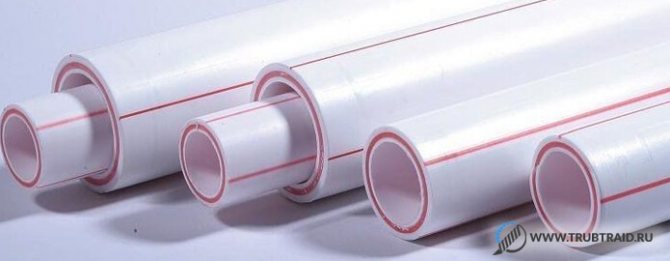

The advantages of this type of communication are greater than those of the previous analogues combined.
Firstly:
structures with pipes reinforced with fiberglass for heating or water supply are highly durable and solid.
Secondly:
for fiberglass-reinforced risers, a relatively low coefficient of thermal expansion is characteristic, which is about 25% less than that of unreinforced counterparts.
Thirdly:
before hot joining, there is no need to clean the ends of the elements to be joined.
Fourthly:
the fiberglass line has increased rigidity.
Fiberglass elements have one drawback, and even that has not yet been fully proven: oxygen penetration through the material.
If this fact is fully confirmed, an accelerated process of corrosion of the metal from which the boilers are made is possible.
Theoretically, such a minus is possible, but in practice, research is still being conducted.
Manufacturing technology
Modern industry successfully implements 4 fundamentally different technologies that allow the production of fiberglass pipe products in various price segments:
We recommend that you familiarize yourself with: Heat-shrinkable couplings for protecting the seams of polyurethane foam pipes
Winding (winding)
Simple and highly efficient technology. It can be simple and continuous. It implies the use of various polymer components: thermoplastic (polypropylene, polyamide, polyethylene, etc.), or thermosetting (polyesters, epoxy resins, phenol-formaldehydes, etc.).
Fiberglass can be laid in various ways. At large industrial enterprises, 4 options are implemented:
- Spiral-ring... The stacking mechanism moves progressively along the rotating workpiece, winding a layer of fibers around it. The required wall thickness is achieved depending on the number of runs. It is used in the manufacture of high-pressure fiberglass products used in critical areas of work: in power lines, rocketry, etc. The production process is complex and expensive; it is not used for large-sized products.
- Longitudinal-transverse... The machine lays the longitudinal and transverse fibers of the material independently of each other.
- Spiral tape... A simplified version that makes it possible to produce inexpensive and practical products at the cost of some reduction in strength. The products are in demand for the installation of low and medium pressure networks.
- Longitudinal-transverse oblique... An innovative technology designed specifically for the military-industrial complex.
Casting (centrifugal molding)
The technology involves manufacturing the pipe in the reverse order - from the outer wall to the inner one.This method makes it possible to increase the wall thickness with almost no restrictions. The pipes have high ring stiffness and can easily withstand large axial loads.
Broaching (pultrusion)
The fiberglass threads, impregnated with a mixture of resins, pass through a forming unit, where, due to the pulling action, they are given the required configuration. Best suited for the production of products used in the construction of water supply, heating, sewerage systems.
Extrusion (extrusion)
The cheapest technology. The viscous pasty billet is continuously pressed through the forming unit. The mixing of fiberglass and resin is chaotic, so the products do not have continuous reinforcement. This negatively affects performance.
How elements are connected to each other
Glass fiber reinforced PPR pipes can be joined into a single structure by diffusion welding or fittings (adapters, couplings, tees and other parts).
Each of the methods uses a special soldering iron, the so-called welding machine. The risers docked in this way create a monolithic non-separable structure.
The presence of special adapters in the form of threaded, flange connections makes it possible to fasten the PPR polypropylene pipe reinforced with fiberglass with a metal line corresponding to the fittings.
What is glass fiber reinforced polypropylene fiber pipe
These products are 3-layer polypropylene pipes reinforced with fiberglass FIBER.
They differ:
- increased resistance to corrosive processes and chemical influences;
- abrasion resistance;
- hygiene. Due to this property, the products have found their application in the installation of drinking water pipelines;
- environmental safety;
- long service life;
- ease of installation.
In addition, the products are versatile in their use.
This is manifested in the fact that they are used:
- when installing underfloor heating, water heating;
- for supplying hot, cold water;
- in the process of arranging drainage, sewerage systems.
Due to the design features of the risers, the product practically does not change its linear dimensions, which is very important when installing heating and ventilation communications.
Varieties
For the implementation of various engineering projects, there are several varieties of fiberglass products. They differ in strength, durability, field of application and, as a result, final cost.
We recommend that you familiarize yourself with: Copper pipes and their use in air conditioners
First of all, the type and concentration of resins added to the mixture during the production process affects the strength characteristics of the pipe. The technology allows the use of isophthalic, orthophthalic, biphenolic resins. This increases the resistance to salts, acids and alkaline compounds.
Also, the strength characteristics of the pipe are increased by increasing the number of layers:
- Single layer pipe. It is produced by winding from pure composite material. Differs in low cost and relatively low performance characteristics.
- Two-layer pipe. It has an additional outer shell that protects the product from mechanical damage, the destructive effects of ultraviolet radiation, and other corrosive environments.
- Three-layer pipe. Each layer of polymer is covered with a protective polyethylene sheath. The layers are joined together by high-temperature polymerization. The layer located in the center is the power one. Its task is to enhance the strength of the product.
When choosing fiberglass pipes for the implementation of a project, it is worth focusing on some important points:
- The pipe material must be free from inclusions of foreign elements.
- The surface should be perfectly flat and smooth, without dents or bulges.
- The edge of each product should not have delamination or cracks - this is a clear sign of rejection.
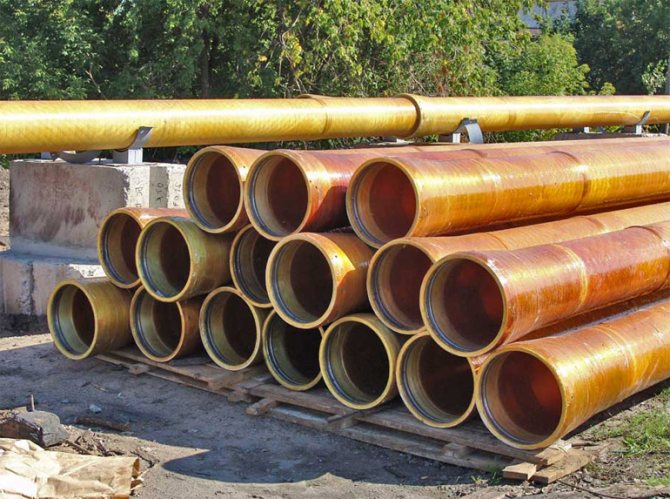

It is important! Fiberglass pipes can be cut, sharpened or drilled. A quality product does not change its performance from these mechanical influences.
How to choose the right one
This question is asked by everyone who deals with the arrangement of pipe structures during repairs or during the construction of a new house. The main thing is that the planned highway is of high quality and cheap.
For an optimal solution to the issue, you need to have knowledge of the technical characteristics of the system that is planned to be built.
Experts advise adhering to certain recommendations regarding other characteristics, the main ones of which are:
- diameter;
- pressure;
- manufacturers.
And then - in more detail.
Required diameters.
Today's market is saturated with products with diameters of 20-110 mm.
In everyday life, elements with a diameter of up to 40 mm are most often used. Risers of this thickness are used for arranging heating, ventilation systems, hot and cold water supply.
In some cases, the most accurate calculations are needed when installing certain communications. In such situations, it is necessary to use the services of specialists who, using formulas, will make the necessary calculations. Taking into account the maximum flow rate of water, the speed of its movement, professionals will tell as accurately as possible what diameter riser should be used in this or that case.
What pressure are the parts designed for?
To a person not familiar with the specifics of such work, the task of choosing a riser that is able to withstand a certain pressure seems rather difficult. But this is at first glance. In fact, the problem is simple to solve.
To do this, you need to: know what pressure the heating or water supply system is designed for and ... be able to read. This means that since there is a marking on all PPR pipes reinforced with fiberglass, it contains all the information about the product. It is there that it is written for what maximum pressure the product is designed.
Mostly, in everyday life, communications with the inscription PN20 are used, which means that the part can be operated in highways with a pressure of up to 20 atm. This number is exaggerated, since no such pressure is observed in household lines. For example, in heating systems of one-story buildings, the nominal pressure is 2.5 - 4 atmospheres. But a margin of safety will not hurt.
With regard to the diameter, it is necessary to select the appropriate fittings.
Important! The best option for the selection of pipes, fittings is the presence of parts not only of the same diameter, but also of the same manufacturer. When installing a structure from such elements, minimal problems are excluded.
Manufacturers
The correct choice of PPR risers also includes the choice of the manufacturer. There is no one specific company whose products would satisfy all customers.
The question is to avoid unnecessary problems. Therefore, preference should be given to that (or those) company, whose reputation in the market for similar goods is impeccable.
Companies from Europe have some advantage in this regard. High quality, reliability in operation, affordable price, which means that the products of companies from Germany and the Czech Republic are popular.
In recent years, the quality of goods from Turkey and China has significantly increased.
Domestic manufacturers are a little behind them, whose products today are distinguished not only by relatively low prices, but also by proper quality. The choice is yours. The main thing is not to buy fakes. Therefore, buy goods in brand stores, while requiring a quality certificate.
In addition to these, there are other reasons that affect the choice of goods. There is, however, one thing: we did not remember at all about the service life of products made of white polypropylene. There is a reason for this. Adhering to the requirements of correct operation, the elements of the pipeline structure are fully capable of withstanding the period of time that is needed to start the next major overhaul of the building.
Such are the materials today.
Features of the appearance of fiberglass pipes
The manufacture of this kind of pipes originated in the 50s of the last century, since it was then that the production of epoxy resins acquired an industrial scale. This technology, like any other novelty, was not very popular at first: people had no experience in using fiberglass, moreover, traditional materials (such as aluminum or steel) were relatively inexpensive.
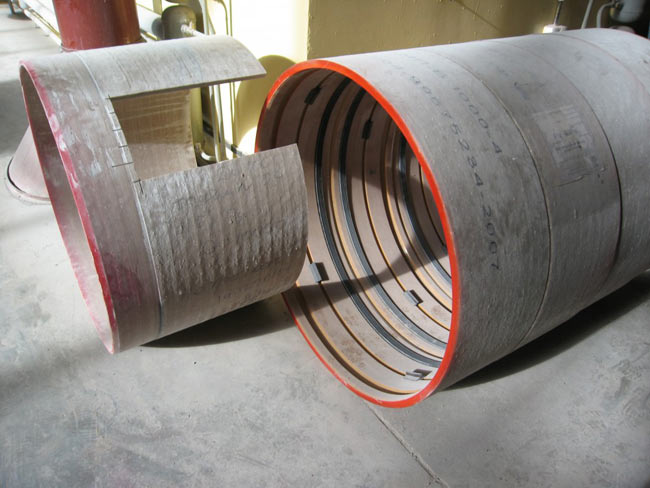

However, after 10-15 years, the situation has changed dramatically. For what reason?
- First of all, this is due to the fact that the cost of steel and non-ferrous metals has increased significantly.
- Pump and compressor pipes made of fiberglass had an advantage over steel pipes - they weighed a little and were distinguished by their resistance to corrosion (pipes did not suffer from prolonged contact with salt water, which cannot be said about their "competitors").
- Another reason, which largely concerns the previous one, is that the commercial development of gas / oil fields has begun to develop.
- And, finally, the production technology itself has changed - now fiberglass pipes were cheaper and became more and more durable.


It is quite obvious that there was no need to wait long for the results - by the end of the sixties from the USA, it burst into the building materials market with high-quality high-pressure fiberglass pipes. Initially, the company's products conquered North America, and therefore moved on to the Middle East market. Already in the eighties, European countries entered the game, and some time later - the Soviet Union.
